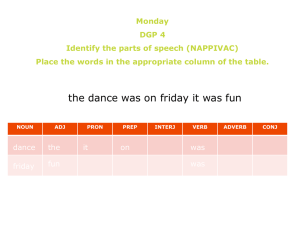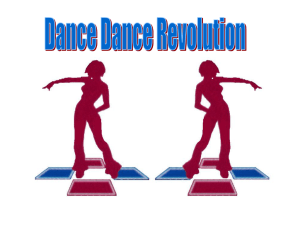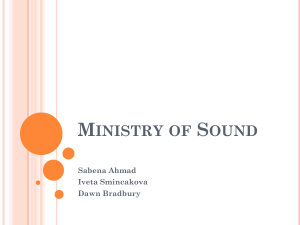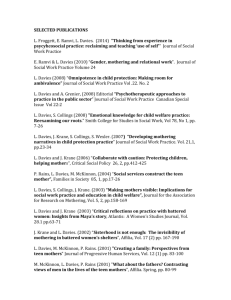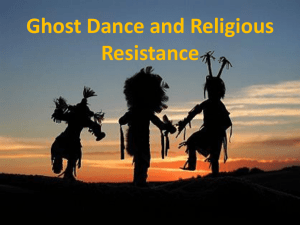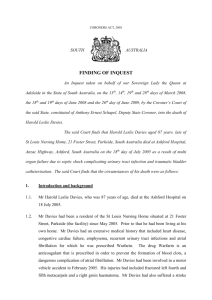Characteristics of Siobhan Davies` work
advertisement
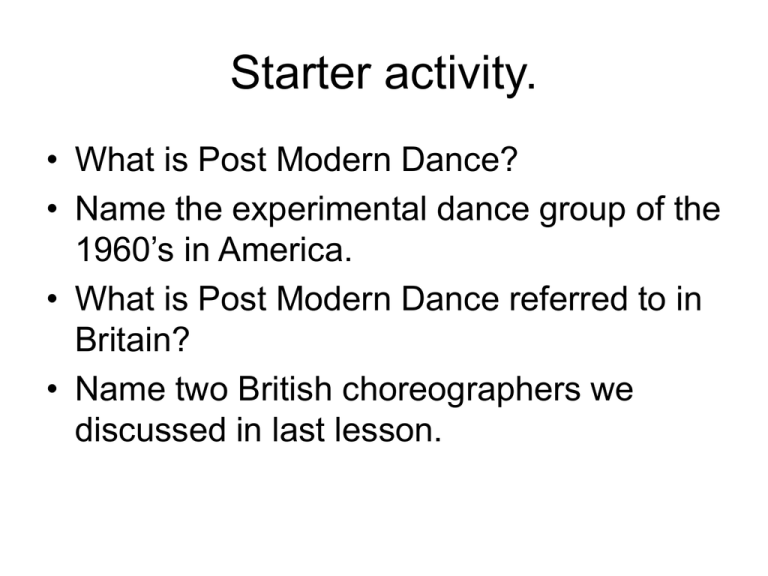
Starter activity. • What is Post Modern Dance? • Name the experimental dance group of the 1960’s in America. • What is Post Modern Dance referred to in Britain? • Name two British choreographers we discussed in last lesson. Homework: Due next Friday. • Practise and rehearse Rap for next week. • Research 4 facts about Siobhan and be prepared to discuss your findings at the beginning of the lesson. Lesson Objectives: To gain knowledge and understanding about choreographer Siobhan Davies, the choreographer of the GCSE set work, Birdsong. To be able to complete an information timeline to be used as an exam revision guide. To complete a group task that will help you remember the key facts about Siobhan Davies for your exam. So What Changed? London Contemporary Dance Theatre 1967 The Place The Laban Centre Ballet Rambert 1966, the Company changes its style from ballet to contemporary dance. Dartington, College of Arts in Devon Henri Oguike • Trained at LCDT • Danced with 4D – postgraduate performance group • Founder member and dancer with the Richard Alston Dance Company • His work is influenced by Cunningham and Alston MARTHA GRAHAM BROUGHT CONTEMPORARY DANCE TO BRITAIN IN THE 1960’S ROBIN HOWARD FUNDED THE OPENING OF LONDON CONTEMPORARY DANCE SCHOOL AND THEATRE. SIOBHAN DAVIES RICHARD ALSTON Siobhan Davies – Choreographer Born in 1950, Sue Davies (Siobhan is her stage name) is now one of the UK’s leading contemporary choreographers. Her initial interest was in art and after leaving school, she studied sculpture at the Hammersmith College of art and building. Davies decided to take dance lessons in Graham technique as a way of discovering more about the body; this was in order to support her art studies. However, dance gradually became important to her as a separate art form. Davies was then part of the early developments of contemporary dance in the UK. When Martha Graham’s student Robert Cohan founded the London Contemporary dance school (LCDS) and theatre (LCDT), Together with Robin Howard, Davies was amongst the very first group of students. She eventually joined LCDT after a year of beginning lessons. Here, she featured in many of Cohen's works. Richard Alston was also a student at LCDS at the same time as Davies; he also came from an art school background. When he began choreographing work for LCDT, Davies danced in them. When Richard Alston created his own dance company; Richard Alston and dancers, Davies worked with him. Siobhan Davies’ first professional work, made for LCDT, was Relay (1972). At this stage, Davies still used Graham based movement vocabulary. Her choreographic style then clearly changed after a trip to America (1976). Here, she attended Cunningham technique classes. On her arrival back to the UK, Davies began experimenting with Cunningham processes. This was evident in her work Step at a Time (1976). Siobhan Davies and dancers was then founded in 1981. Soon after, this was renamed Siobhan Davies dance company (SDDC). Davies is interested in bringing dance to different venues and nontheatrical spaces. Plants and ghosts (2002) was performed in an aircraft hanger because these present new choreographic challenges. She has received numerous awards including the Olivier Awards for outstanding achievement in dance in 1993 and 1996. In 2002, she was made a CBE. Timeline Born in ____ One of the UK’s _________ ____________ ______________ Davies decided to take ______ ________ ___ _______ __________ as a way of discovering more about the body. Dance gradually became important to her as a _________ ____ ______. Davies was then part of the _______ _______________ of _______________ ________ in the UK. Trained at _________ _________________ dance school and was amongst the very first group of students. She eventually joined LCDT _______ __ ______ of ___________ _________. Davies worked with __________ Alston and ________. Siobhan Davies’ first professional work, made for _____, was ________ (_____). Her ________________ _______ then clearly changed after a trip to _________ (_____). Here, she attended _____________ __________ classes. •Pedestrian gestures; Characteristics of Siobhan Davies’ work •Isolations of joints; •Actions can be focused in joints; •Use of all body parts. •Contrasts in Dynamics: speed and quality. •Proximity and distance (near and far) •Small and large movements used. •Use of many facings and directions. •Linear and curved pathways. •Use of Canon and unison. •Use of freeze frames. •Many formations used between dancers. •Repetition and reordering. Arabesque, attitude. Balance, bend, bounce, brake. Carry, cartwheel, circle, clap, clench, click, collapse, contract, curl, creep, curve. Dart, dig, dive, drag, drop. Enlarge, elevate, enter, exit, explode, extend. Fall, flex, fold, freeze. Gallop, gesture, grab, grip, hang, hold, hop. Jab, jump. Kick, kneel, knock. Lean, leap, lengthen, lie, look, lower, lunge. Melt, mime, move. Pierce, pivot, pull, punch, push. Reach, rise, roll, run. Shake, shoulder-stand, shrink, shuffle, sit, slide, stamp, stand, step, stretch, swing. Tap, tilt, travel, turn, twist, Unfold. Walk, watch, wrap. Movements regularly used by Siobhan Davies Ring-a-ring o'roses A pocket full of posies, Atishoo! Atishoo! We all fall down. Picking up the daises, picking up the daises, Atishoo!, Atishoo! We all jump up. Baa, Baa, Black Sheep. Baa, baa, black sheep, Have you any wool? Yes, sir, yes, sir, Three bags full; One for my master, And one for my dame, and one for the little boy Who lives down the lane. Hey diddle diddle, The cat and the fiddle, The cow jumped over the moon. The little dog laughed To see such fun, And the dish ran away with the spoon. The Grand Old Duke of York Mary Mary Sing a Song of Sixpence Jack and Jill Incey Wincey Spider SIOBHAN DAVIES LIKES DETAILED ACTIONS, PEDESTRIAN GESTURES AND ISOLATIONS. PROXIMITY AND DISTANCE IS THE KEY, SLOW MOTION, STILLNESS AND COMPLEX ENERGY.




